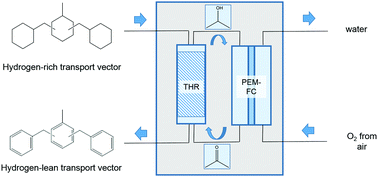Towards an efficient liquid organic hydrogen carrier fuel cell concept†
Abstract
The high temperature required for hydrogen release from Liquid Organic Hydrogen Carrier (LOHC) systems has been considered in the past as the main drawback of this otherwise highly attractive and fully infrastructure-compatible form of chemical hydrogen storage. According to the state-of-the art, the production of electrical energy from LOHC-bound hydrogen, e.g. from perhydro-dibenzyltoluene (H18-DBT), requires provision of the dehydrogenation enthalpy (e.g. 65 kJ mol−1 (H2) for H18-DBT) at a temperature level of 300 °C followed by purification of the released hydrogen for subsequent fuel cell operation. Here, we demonstrate that a combination of a heterogeneously catalysed transfer hydrogenation from H18-DBT to acetone and fuel cell operation with the resulting 2-propanol as a fuel, allows for an electrification of LOHC-bound hydrogen in high efficiency (>50%) and at surprisingly mild conditions (temperatures below 200 °C). Most importantly, our proposed new sequence does not require an external heat input as the transfer hydrogenation from H18-DBT to acetone is almost thermoneutral. In the PEMFC operation with 2-propanol, the endothermal proton release at the anode is compensated by the exothermic formation of water. Ideally the proposed sequence does not form and consume molecular H2 at any point which adds a very appealing safety feature to this way of producing electricity from LOHC-bound hydrogen, e.g. for applications on mobile platforms.



 Please wait while we load your content...
Please wait while we load your content...